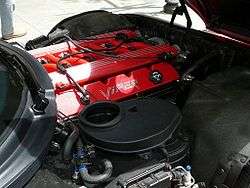Viper engine
| Viper engine | |
|---|---|
|
The Viper engine on the ZB I version of the Viper. | |
| Overview | |
| Manufacturer | Chrysler |
| Production |
1992–2010 2012–2017 |
| Layout | |
| Configuration | Naturally aspirated 90° V10 |
| Displacement |
|
| Cylinder bore |
|
| Piston stroke |
|
| Cylinder block alloy | Aluminum |
| Cylinder head alloy | Aluminum |
| Valvetrain | OHV 2 valves per cylinder |
| Compression ratio | 9.6:1, 10.2:1 |
| Combustion | |
| Fuel system | Multi-port fuel injection |
| Fuel type | Gasoline |
| Oil system | Wet sump |
| Cooling system | Water cooled |
| Output | |
| Power output |
|
| Torque output |
|
| Dimensions | |
| Dry weight |
|
The Viper engine is a high-performance naturally aspirated pushrod 2 valves per cylinder 90° V10 engine built by Chrysler for use in the vehicle of the same name.
History
Production of the V10 engine started at Mound Road Engine before moving to Conner Avenue Assembly, where the Viper itself is built, in May 2001. In addition, the Viper V10 was installed in the Dodge Ram SRT-10, earning the truck the Guinness World Record for fastest production truck (later bettered by an Australian production car; the Holden HSV Maloo that uses the LS2, Corvette engine, into the pickup truck category ). The Dodge Tomahawk concept vehicle also uses this engine. Bitter Cars of Germany produced the Bitter GT1 based on the Lotus Elise GT1 using this engine.
The V10 was also sold to British luxury car manufacturer Bristol Cars: the Bristol Fighter was powered by a modified version of the engine which produced 525 bhp (532 PS; 391 kW), increasing to 550 bhp (558 PS; 410 kW) at high speed due to the ram air effect.[1] In the more powerful Fighter S the engine was tuned to give 628 bhp (637 PS; 468 kW) (660 bhp (669 PS; 492 kW) at high speed). Bristol had also planned to produce the Fighter T, the V10 would have been further modified and turbocharged to produce 1,012 bhp (1,026 PS; 755 kW) at 5600 rpm, slightly more than the advertised 1,001 PS (987 bhp; 736 kW) of the Bugatti Veyron, however Bristol have since stated that no Fighter T models were produced.[2]
Development
Phase SR (1992–2002)

- SR I (1st Generation)
The Viper V10 is based on the Chrysler LA engine family, and appeared with the Dodge Viper in 1992. It was conceived and prototyped as a Magnum 5.9 with two extra cylinders and a longer stroke of 3.88 in (98.6 mm).
Lamborghini engineers revamped Dodge's cast-iron block V10 engine for the Viper by redesigning the block and heads in aluminium alloy.[3] Prototype blocks were cast by Lamborghini, at the time a Chrysler division.
The first-generation Viper V10 engine had a displacement of 7,990 cc (8.0 L; 487.6 cu in) and produced 400 hp (406 PS; 298 kW) at 4600 rpm and 465 lb⋅ft (630 N⋅m) of torque at 3600 rpm.[4]
- SR II (2nd Generation)
The second-generation engine, also displacing 8.0 L, produced 450 hp (456 PS; 336 kW) @ 5200 rpm and 490 lb⋅ft (664 N⋅m) of torque @ 3700 rpm.[5]
Phase ZB (2003–2010)
- ZB I (3rd Generation)
The third-generation engine, introduced on the 2003 Viper, had a displacement of 8,285 cc (8.3 L; 505.6 cu in) with a bore x stroke of 102.4 mm × 100.6 mm (4.03 in × 3.96 in), rated at 510 hp (517 PS; 380 kW) @ 5600 rpm and 535 lb⋅ft (725 N⋅m) @ 4200 rpm of torque after SAE certification in 2006.[6]
- ZB II (4th Generation)
For the 2008 Dodge Viper, the engine's output was increased to 600 bhp (608 PS; 447 kW) @ 6100 rpm and 560 lb⋅ft (759 N⋅m) @ 5000 rpm of torque via a slight displacement increase to 8,382 cc (8.4 L; 511.5 cu in) and the use of variable valve timing, among the first utilized in a pushrod engine. The bore was now 4.055 in (103.0 mm), the same as Chrysler's 6.1 L Hemi engine.[7]
Phase VX (2012–2017)
- VX I (5th Generation)
The 2013 SRT Viper kept roughly the same displacement but further boosted power to 640 hp (649 PS; 477 kW) @ 6150 rpm and 600 lb⋅ft (813 N⋅m) @ 4950 rpm of torque.[8] Since 2015, power was raised up to 645 hp (654 PS; 481 kW) at 6200 rpm.[9]
See also
References
- ↑ "Bistol Fighter". Archived from the original on 2010-10-28.
- ↑ "Archived copy". Archived from the original on 2012-07-03. Retrieved 2010-07-08.
- ↑ Car: The Definitive Visual History of the Automobile. Penguin. 2011. p. 296. ISBN 9780756689384. Retrieved 22 July 2018.
- ↑ Pawel Zal (ed.). "1992 Dodge Viper RT/10". Automobile-catalog.com. Retrieved 2018-09-14.
- ↑ "1996 - 2002 Dodge Viper GTS". ultimatecarpage.com. Retrieved June 25, 2018.
- ↑ "2006 Dodge Viper SRT-10 Coupé". carfolio.com. Retrieved June 25, 2018.
- ↑ "2007 Dodge Viper SRT10 ACR, 2008 MY US". carfolio.com. Retrieved June 25, 2018.
- ↑ NIck D., ed. (April 15, 2016). "2013 Dodge SRT-Viper GTS". supercars.net. Retrieved June 25, 2018.
- ↑ "Dodge Viper GTS, 2016 MY". Carfolio.com. 2016-12-27. Retrieved 2018-09-14.
External links
| Wikimedia Commons has media related to Viper engines. |